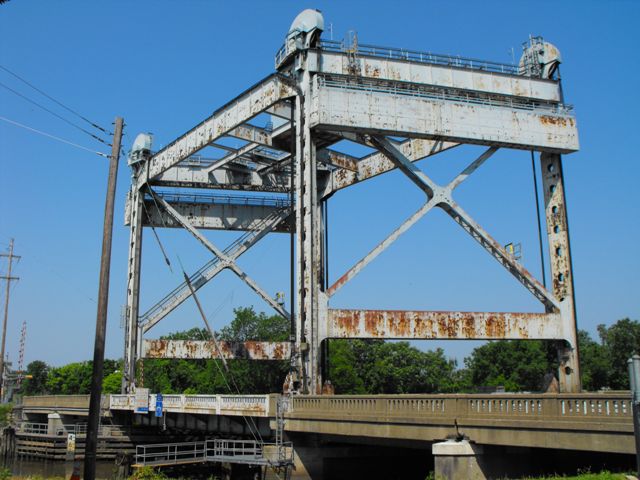We Recommend:
Bach Steel - Experts at historic truss bridge restoration.
BridgeHunter.com Phase 1 is released to the public! - Visit Now
Bridgeport Bridge

Primary Photographer(s): Nathan Holth and Rick McOmber
Bridge Documented: May 31, 2010
Bridgeport: Gloucester County, New Jersey: United States
Metal Through Girder, Movable: Vertical Lift (Tower Drive) and Approach Spans: Metal Stringer (Multi-Beam), Fixed
1940 By Builder/Contractor: Unknown and Engineer/Design: Ash, Howard, Needles, and Tammen of New York, New York
Not Available or Not Applicable
86.0 Feet (26.2 Meters)
285.0 Feet (86.9 Meters)
52.2 Feet (15.91 Meters)
1 Main Span(s) and 4 Approach Span(s)
817151

View Information About HSR Ratings
Bridge Documentation
This bridge no longer exists!
Bridge Status: Demolished and replaced as of 2019.View Archived National Bridge Inventory Report - Has Additional Details and Evaluation
This bridge is one of three vertical lifts along this section of roadway. The bridges are excellent representative examples of medium-sized vertical lift bridges. Having smaller spans than the large vertical lift bridges such as those seen in Chicago, or on the Welland Canal in Ontario, the main lift span is not a through truss, but is instead a through plate girder. These bridges are noteworthy New Jersey examples of the smaller lift bridges seen in places such as southern Louisiana. The Historic Bridge Inventory for New Jersey provides an extensive narrative for the bridge below.
Aesthetically, the bridges are noted for their attractive railings. Although the approach spans have concrete railings and the main span has steel railings, they have the same pierced openings that provide a consistent appearance. The approach spans are steel stringer spans but include a concrete encasement to give the appearance of concrete beams.
The Bridgeport Bridge is in particular noted for its wide width and its 27 degree skew. The bridge continues to operate a number of times per day for boats, and the bridgetender building is staffed.
Information and Findings From New Jersey's Historic Bridge InventorySummary The skewed vertical lift bridge has a thru-girder moveable span, built-up towers with portal bracing and longitudinal girders, concrete counterweights with steel-plate frames, and a steel grate deck. It is a distinguished and well-preserved example of a "Waddell-type" vertical lift. The bridge is the largest and newest of three vertical lifts built by the state in the county between 1935-1940. All are eligible. The tender's shanty was replaced in 1988. Physical Description The four-lane bridge is a single-span movable Waddell-type vertical lift with four encased steel stringer approach spans. Its overall length is 285' with a 52' roadway. The main vertical lift span, which is skewed, consists of a single, 93'-long toe-to-toe, thru girder with floor beams. The span is constructed to permit it being lifted vertically to a height of 64' clear above mean low water. At each end of the main span are steel towers approximately 95'-high. Each tower consists of two built-up girder legs with horizontal and diagonal sway bracing. Between the tops of the opposite towers pass two girders, and suspended between the girders is the central overhead machinery house. Cantilevered off both sides of the main span are concrete deck sidewalks with sheet metal balustrades. The main span is operable. Power for lifting the bridge is supplied from the central overhead machinery house that contains an electric motor and a back-up gas engine. At the top of each of the four tower legs are sheaves over which pass steel-wire ropes. The ropes are attached at one end to counterweights and at the other to couplings attached to the roadway. Power is transmitted from the motor to the sheave coupling by means of direct drive line shafting and gears. The span moves up and down along a C-shaped guide on the interior of the tower legs. The machinery is equipped with brakes, clutch, and locks. The two counterweights consist of concrete blocks held within riveted steel plate frames on the exterior side of the tower legs. The approach spans are concrete encased steel stringers with concrete balustrades and sidewalks. There are four approach spans, two to the north and two to the south of the main span. The bridge has a concrete substructure with cutwater piers. The fenders are timber piling. At each end of the main span are safety gates original to the bridge construction. Additional modern safety gates have been added at the abutment ends of the approach spans. Northeast of the northern approach span is a modern two-story operator's house. Historical and Technological Significance The vertical lift bridge across Raccoon Creek is a well-preserved and operable example of a historically and technologically significant bridge type. The vertical lift type represented important advances in structural steel construction, and was an alternative to bascule and swing span type movable bridges. The Raccoon Creek Bridge is one of three vertical lifts along old New Jersey Highway Route 44 in Salem and Gloucester Counties. All three bridges, built between 1935 and 1940, have been recommended as eligible because they represent an increasingly rare early 20th-century bridge type. Vertical lift bridges are a special bridge type combining both mechanical and civil engineering technologies. The first vertical lift bridge of importance in the United States was designed by well-known bridge engineer, J. A. L. Waddell. In 1894 he oversaw the construction of the South Halsted Street Bridge over the Chicago River in Chicago, Illinois. The bridge, which had overhead trusses between the towers and sheaves at the top of each tower leg, became known as the Waddell-type vertical lift. Beginning in 1908 vertical lift bridges were built in increasing numbers, often replacing swing-span type movable bridges. According to bridge engineer H. E. Pulver (1923) the advantages of the vertical lift included simplicity of design, rigidity, reliability, ease of operation, short time of operation (usually 40-50 seconds), power economy, cost of operation, and less chance of collision with boats. The bridge type was particularly suitable to long span crossings where high navigational clearance was required. The Raccoon Creek Bridge was built in 1940 as part of the reconstruction of NJ Highway Route 44. The firm of Ash, Howard, Needles, and Tammen of New York and Kansas City acted as consulting engineers on the New Deal public works project. The bridge survives with few significant alterations. In c.1985 the electric motors were rehabilitated and locking mechanism added. As well, a new operator's house was constructed on the Bridgeport side of the creek. The original operator's house and dwelling, which plans show on the opposite bank of the creek, have been demolished. The bridge still opens to navigation, mostly to pleasure craft in the summer. At one time Raccoon Creek was navigable upstream to Swedesboro, which was a shipping point for lumber and fresh produce. The Raccoon Creek Bridge is the youngest of the three bridges on old NJ Highway Route 44. It differs from the other two in that it is skewed; it has a 4-lane roadway instead of a 2-lane; and, it has tower legs and bracing of built-up girders rather than riveted angle, channel, and beam columns and trusses. The oldest vertical lift bridge, NJ 44 over Mantua Creek in Paulsboro (0806150), is still operable and has been outfitted with new operating machinery and operator's house. The second oldest bridge, US 130 over Oldmans Creek (1710152) is no longer operable, but retains its original operator's house. As a group the bridges are neither the oldest or largest of their type in the United States, however, they are significant engineering achievements representing the application of vertical lift bridge technology to medium-span crossings. Sources New Jersey State Highway Commission, Division of Bridges, Raccoon Creek Bridge
Plans, 1938. Discussion of Surrounding Area The four-lane, heavily-skewed, vertical-lift bridge spans Raccoon Creek on the southern edge of Bridgeport near the Commodore Barry Bridge to Chester, PA. The bridge is the furthest downstream of three movable bridges across Raccoon Creek and is still operable. On the northern bank is a modern, two-story operator's house (c. 1988) neighboring a number of small residences and businesses (c. 1830-1950). Bridge Considered Historic By Survey: Yes, and Evaluated in Management Plan |
![]()
Photo Galleries and Videos: Bridgeport Bridge
Bridge Photo-Documentation
Original / Full Size PhotosA collection of overview and detail photos. This gallery offers photos in the highest available resolution and file size in a touch-friendly popup viewer.
Alternatively, Browse Without Using Viewer
![]()
Bridge Photo-Documentation
Mobile Optimized PhotosA collection of overview and detail photos. This gallery features data-friendly, fast-loading photos in a touch-friendly popup viewer.
Alternatively, Browse Without Using Viewer
![]()
Westbound Crossing of the Bridge
Full Motion VideoStreaming video of the bridge. Also includes a higher quality downloadable video for greater clarity or offline viewing.
![]()
Maps and Links: Bridgeport Bridge
This historic bridge has been demolished. This map is shown for reference purposes only.
Coordinates (Latitude, Longitude):
Search For Additional Bridge Listings:
Bridgehunter.com: View listed bridges within 0.5 miles (0.8 kilometers) of this bridge.
Bridgehunter.com: View listed bridges within 10 miles (16 kilometers) of this bridge.
Additional Maps:
Google Streetview (If Available)
GeoHack (Additional Links and Coordinates)
Apple Maps (Via DuckDuckGo Search)
Apple Maps (Apple devices only)
Android: Open Location In Your Map or GPS App
Flickr Gallery (Find Nearby Photos)
Wikimedia Commons (Find Nearby Photos)
Directions Via Sygic For Android
Directions Via Sygic For iOS and Android Dolphin Browser
USGS National Map (United States Only)
Historical USGS Topo Maps (United States Only)
Historic Aerials (United States Only)
CalTopo Maps (United States Only)


